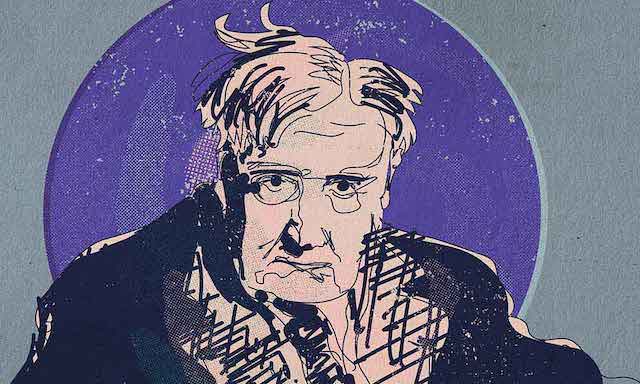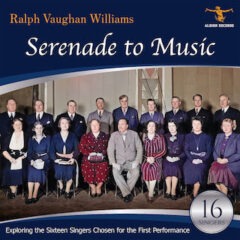
Ralph Vaughan Williams illustration by uDiscover Music
By Robert Hugill
 RALPH VAUGHAN WILLIAMS: SERENADE TO MUSIC
RALPH VAUGHAN WILLIAMS: SERENADE TO MUSIC
Exploring the Sixteen Singers Chosen for the First Performance
Albion Records
A remastering of the iconic 1938 recording along with a solo track from each of the sixteen soloists (plus one extra) provides a wondrous snapshot of British singing in the 1930s
Ralph Vaughan Williams’ Serenade to Music has become rightly become iconic and on this disc from Albion Records the original 1938 recording is explored from a different angle. Written for 16 soloists and orchestra, the text is an adaptation of the discussion about music and the music of the spheres in Act V, Scene 1 of Shakespeare’s The Merchant of Venice (see lyrics below). This Albion release is the original recording with a group of Britain’s foremost soloists of the day–Isobel Baillie, Elise Suddaby, Eva Turner, Stiles-Allen, Muriel Brunskill, Astra Desmond, Margaret Balfour, Mary Jarrod, Walter Widdop, Parry Jones, Frank Titterson, Heddle Nash, Roy Henderson, Robert Easton, Harold Williams, and Norman Allin–conducted by Sir Henry Wood with the BBC Symphony Orchestra. Serenade to Music is a little more than 14 minutes in length, so the CD’s bonus to listeners is in the addition of recordings made by these eminent vocalists individually before and after the Serenade to Music session. One extra track features Keith Falkner, who was unavailable for the original recording.
All the singers had a long association with Sir Henry Wood and the premiere of Serenade to Music took place on 5 October 1938 at the Queen’s Hall, and the program included not only RVW’s piece but Rachmaninoff as the soloist in his Piano Concerto No. 2. Ten days later, the singers reassembled at Abbey Road Studios to record the work. It would not be the last time that they performed the work. Isobel Baillie in her autobiography records a post-war performance with the original singers, with Baillie joking about the strain on the stage as all were significantly heavier than they had been in 1938!

‘Serenade to Music,’ Ralph Vaughan Williams, the original 1938 version for 16 soloists and orchestra. The text is an adaptation of the discussion about music and the music of the spheres in Act V, Scene 1 of The Merchant of Venice by William Shakespeare. Vaughan Williams wrote the piece as a tribute to the conductor Sir Henry Wood to mark the fiftieth anniversary of Wood’s first concert. The solo parts were composed specifically for the voices of sixteen eminent British singers chosen by Wood and the composer. In some parts of the work, the soloists sing together as a “choir,” sometimes in as many as twelve parts; in others, each soloist is allotted a solo (some soloists get multiple solos). The published score places the initials of each soloist next to his or her lines. Wood conducted the first performance at his jubilee concert at the Royal Albert Hall on 5 October 1938. The orchestra comprised players from the three London orchestras–the London Symphony Orchestra, the BBC Symphony Orchestra and the London Philharmonic Orchestra. On 15 October 1938, Wood made the first recording (with the same soloists and the BBC Symphony Orchestra) at the HMV Abbey Road Studio No. 1. Vaughan Williams and HMV donated copyright fees received from the initial record sales to The Henry Wood Jubilee Fund, which was established to endow London hospital beds for British orchestral musicians.
The selection of solo numbers is, to an extent, idiosyncratic. The selection was made from the collections of Stephen Connock and the late Donald Mitchell, which means that for a singer like (Lillian) Stiles-Allen there was only one possible choice. The selection is also limited by the idiosyncratic choice of repertoire for British singers of this period. Baillie, again, in her autobiography talks about them not being the first choice for record companies and when the economic going got tough in the later 1930s, the British singers were dropped so there is a significant gap in Baillie’s recorded output, whilst Walter Widdop’s operatic recording career virtually stopped after the later 1930s.

‘Heavenly Vision,’ Robert Easton and Heddie Nash, a solo recording by singers appearing on the original Serenade to Music, included on the remastered 2024 release.
We have a selection of apposite operatic recordings, Eva Turner in “Vissi d’arte” from Puccini’s Tosca, Stiles-Allen in “Santuzza’s song” from Mascagni’s Cavalleria Rusticana, Frank Titterton and Heddle Nash in the duet, “Ah, Mimi, tu piu non torni” from Puccini’s La Boheme, Robert Easton and Heddle Nash in the duet “Heavenly Vision” from Gounod’s Faust, and Harold Williams in the Prologue from Leoncavallo’s Pagliacci, as well as Margaret Balfour in the “Angel’s Farewell” from Elgar’s The Dream of Gerontius conducted by the composer.
The remainder are song repertoire that veers between Victorian charm and the more contemporary, Isobel Baillie in the Bach-Gounod Ave Maria, Elsie Suddaby in Somervell’s Shepherd’s Cradle Song, Muriel Brunskill in Bantock’s Serenade, Astra Desmond in the traditional Mull Fisher’s Love Song, Mary Jarred in Parry’s England, Walter Widdop in Woodforde-Finden’s A Request, Parry Jones in Warlock’s There is a lady sweet and kind, Heddle Nash in Linden Lea, Norman Allin in Silent Noon, and Keith Falkner in Butterworth’s Is my team ploughing.

‘Ave Maria’ (Bach and Gounod) performed by Isobel Baillie, a solo recording by one of the 16 vocalists appearing on the original Serenade to Music included on the remastered 2024 release.
Some tracks are real highlights, demonstrating just why that particular singer was notable. The opening track might only be Gounod’s take on Bach but Isobel Baillie is never louder than lovely and the purity of her upper register (notable for the lack of vibrato) demonstrate why she got the the final note in Serenade to Music. Eva Turner’s ‘Vissi d’arte’ also demonstrates her laser-like clarity, and also highlights one of the problems with RVW’s piece. It was written for singers from a particular period, with a particular type of vocal production, well before the post-war, post-Callas equating of bigness of sound with vibrato, and many of the singers have that laser like clarity. It is also worth bearing in mind that all the singers on this disc, whatever their chosen repertoire, made a living by singing oratorio, whatever size and type the voice, the regular Messiahs, Elijahs and such were the bread and butter. It is this, I think, that contributes to their distinctive sound.

‘Linden Lea,’ RVW’s first published song, performed by Heddie Nash, one of the 16 vocalists appearing on the original Serenade to Music. This recording is included on the remastered 2024 release.
Another rarity is Margaret Balfour, who in the Angel’s Farewell recorded in 1927, demonstrates a true contralto. If we might regret the missed opportunity for hearing Walter Widdop in something dramatic, his account of Woodeforde-Finden’s A Request demonstrates the way he can focus his voice down and sing with poise and superb diction (despite having Siegfried in his repertoire). And the same might be said of Parry Jones in Warlock’s There is a lady sweet and kind. The RVW songs are gems, Heddle Nash’s Linden Lea (RVW’s first published song, in 1902, when he was 30) is masterful complete with the sort of diction that he was known for, whilst Norman Allin’s Silent Noon combines ruggedness with an ability to conjure the song aptly. There are two Butterworth songs, Roy Henderson is touching if rather period in Loveliest of Trees, and Keith Falkner’s rather wonderful Is my team ploughing with Gerald Moore at the piano.

‘Serenade,’ written by Peter Warlock, performed by Muriel Brunskill, one of the 16 vocalists appearing on the original Serenade to Music.This recording is included on the remastered 2024 release.
Frank Titterton and Roy Henderson’s duet from La Boheme is notable partly for being recorded in the original language rather than English and has a vividness to it despite a certain stiffness of English delivery. Robert Easton and Heddle Nash’s duet from Faust is in English, conducted by Sir Thomas Beecham, and is most notable for Easton’s vivid, tight-vibrato-laden voice that makes his contribution to Serenade to Music so noticeable. Harold William’s account of the Prologue from Pagliacci uses the British National Opera Company’s orchestra, conducted by Eugene Goosens. In English and vividly period, but terrific all the same.
And Serenade to Music itself? It has been wonderfully remastered and the performance remains pure, unrepeatable magic, capturing a moment in time, that never fails to bring a tingle to the back of the neck.
Serenade to Music
English source: William Shakespeare
How sweet the moonlight sleeps upon this bank!
Here will we sit, and let the sounds of music
Creep in our ears: soft stillness and the night
Become the touches of sweet harmony.
Look, how the floor of heaven
Is thick inlaid with patines of bright gold:
There’s not the smallest orb that thou behold’st
But in his motion like an angel sings
Still quiring to the young-eyed cherubins;
Such harmony is in immortal souls;
But, whilst this muddy vesture of decay
Doth grossly close it in, we cannot hear it.
Come, ho! and wake Diana with a hymn:
With sweetest touches pierce your mistress’ ear,
And draw her home with music.
I am never merry when I hear sweet music.
The reason is, your spirits are attentive:
The man that hath no music in himself,
Nor is not mov’d with concord of sweet sounds,
Is fit for treasons, stratagems and spoils;
The motions of his spirit are dull as night,
And his affections dark as Erebus:
Let no such man be trusted… Music! hark!
It is your music of the house.
Methinks it sounds much sweeter than by day.
Silence bestows that virtue on it.
How many things by season season’d are.
To their right praise and true perfection!
Peace, ho! the moon sleeps with Endymion,
And would not be awak’d.
(Soft stillness and the night
Become the touches of sweet harmony.)

 Reviews published here by permission of Robert Hugill at Planet Hugill (www.planethugill.com), a singer, composer, journalist, lover of opera and all things Handel. To receive Robert’s lively “This month on Planet Hugill” e-newsletter, sign up on his Mailing List. Robert Hugill photo by Robert Piwko. Mr.Hugill’s review of Serenade to Music was published at Planet Hugill on 3 April 2024.
Reviews published here by permission of Robert Hugill at Planet Hugill (www.planethugill.com), a singer, composer, journalist, lover of opera and all things Handel. To receive Robert’s lively “This month on Planet Hugill” e-newsletter, sign up on his Mailing List. Robert Hugill photo by Robert Piwko. Mr.Hugill’s review of Serenade to Music was published at Planet Hugill on 3 April 2024.


